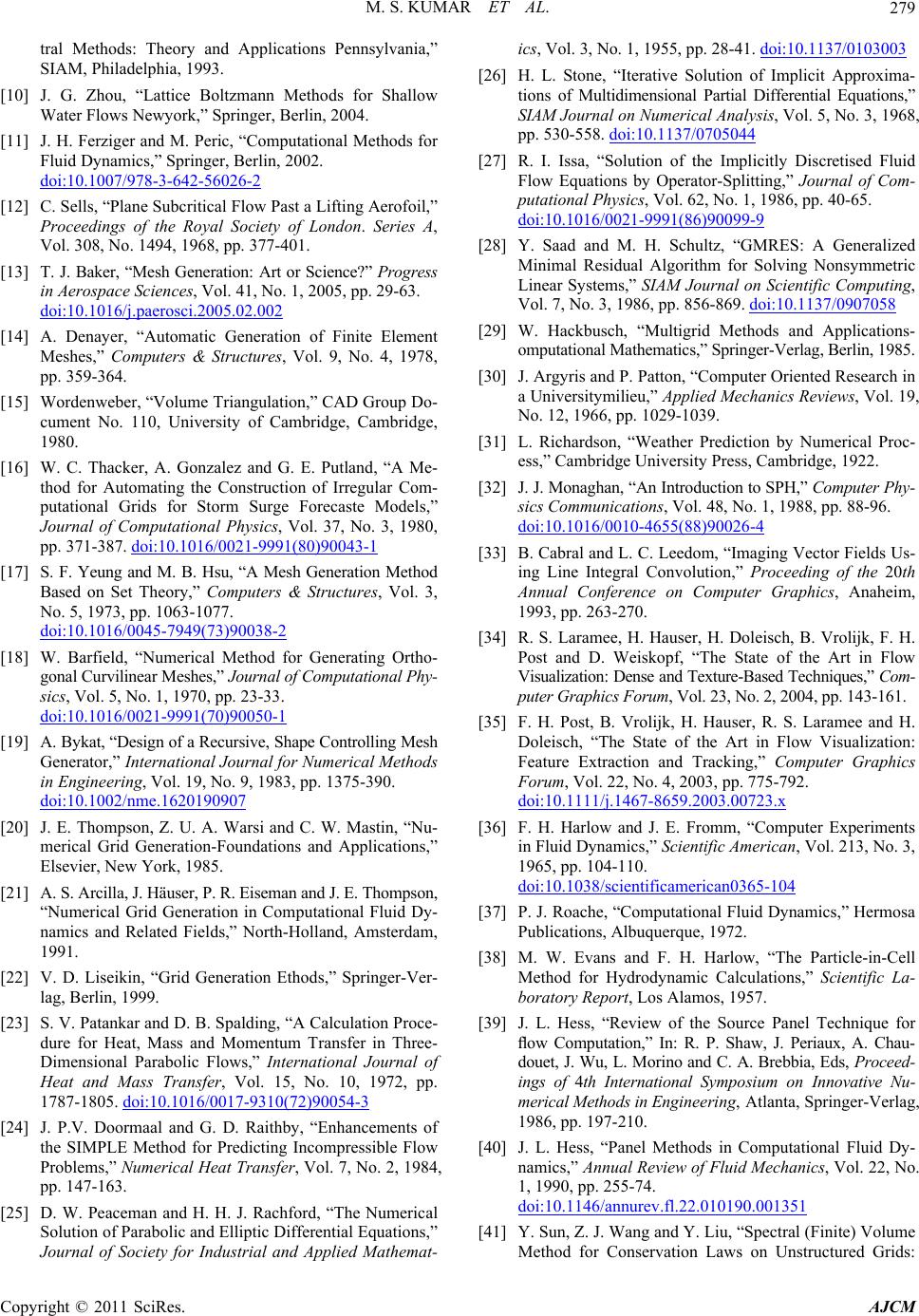
M. S. KUMAR ET AL.279
tral Methods: Theory and Applications Pennsylvania,”
SIAM, Philadelphia, 1993.
[10] J. G. Zhou, “Lattice Boltzmann Methods for Shallow
Water Flows Newyork,” Springer, Berlin, 2004.
[11] J. H. Ferziger and M. Peric, “Computational Methods for
Fluid Dynamics,” Springer, Berlin, 2002.
doi:10.1007/978-3-642-56026-2
[12] C. Sells, “Plane Subcritical Flow Past a Lifting Aerofoil,”
Proceedings of the Royal Society of London. Series A,
Vol. 308, No. 1494, 1968, pp. 377-401.
[13] T. J. Baker, “Mesh Generation: Art or Science?” Progress
in Aerospace Sciences, Vol. 41, No. 1, 2005, pp. 29-63.
doi:10.1016/j.paerosci.2005.02.002
[14] A. Denayer, “Automatic Generation of Finite Element
Meshes,” Computers & Structures, Vol. 9, No. 4, 1978,
pp. 359-364.
[15] Wordenweber, “Volume Triangulation,” CAD Group Do-
cument No. 110, University of Cambridge, Cambridge,
1980.
[16] W. C. Thacker, A. Gonzalez and G. E. Putland, “A Me-
thod for Automating the Construction of Irregular Com-
putational Grids for Storm Surge Forecaste Models,”
Journal of Computational Physics, Vol. 37, No. 3, 1980,
pp. 371-387. doi:10.1016/0021-9991(80)90043-1
[17] S. F. Yeung and M. B. Hsu, “A Mesh Generation Method
Based on Set Theory,” Computers & Structures, Vol. 3,
No. 5, 1973, pp. 1063-1077.
doi:10.1016/0045-7949(73)90038-2
[18] W. Barfield, “Numerical Method for Generating Ortho-
gonal Curvilinear Meshes,” Journal of Computational Phy-
sics, Vol. 5, No. 1, 1970, pp. 23-33.
doi:10.1016/0021-9991(70)90050-1
[19] A. Bykat, “Design of a Recursive, Shape Controlling Mesh
Generator,” International Journal for Numerical Methods
in Engineering, Vol. 19, No. 9, 1983, pp. 1375-390.
doi:10.1002/nme.1620190907
[20] J. E. Thompson, Z. U. A. Warsi and C. W. Mastin, “Nu-
merical Grid Generation-Foundations and Applications,”
Elsevier, New York, 1985.
[21] A. S. Arcilla, J. Häuser, P. R. Eiseman and J. E. Thompson,
“Numerical Grid Generation in Computational Fluid Dy-
namics and Related Fields,” North-Holland, Amsterdam,
1991.
[22] V. D. Liseikin, “Grid Generation Ethods,” Springer-Ver-
lag, Berlin, 1999.
[23] S. V. Patankar and D. B. Spalding, “A Calculation Proce-
dure for Heat, Mass and Momentum Transfer in Three-
Dimensional Parabolic Flows,” International Journal of
Heat and Mass Transfer, Vol. 15, No. 10, 1972, pp.
1787-1805. doi:10.1016/0017-9310(72)90054-3
[24] J. P.V. Doormaal and G. D. Raithby, “Enhancements of
the SIMPLE Method for Predicting Incompressible Flow
Problems,” Numerical Heat Transfer, Vol. 7, No. 2, 1984,
pp. 147-163.
[25] D. W. Peaceman and H. H. J. Rachford, “The Numerical
Solution of Parabolic and Elliptic Differential Equations,”
Journal of Society for Industrial and Applied Mathemat-
ics, Vol. 3, No. 1, 1955, pp. 28-41. doi:10.1137/0103003
[26] H. L. Stone, “Iterative Solution of Implicit Approxima-
tions of Multidimensional Partial Differential Equations,”
SIAM Journal on Numerical Analysis, Vol. 5, No. 3, 1968,
pp. 530-558. doi:10.1137/0705044
[27] R. I. Issa, “Solution of the Implicitly Discretised Fluid
Flow Equations by Operator-Splitting,” Journal of Com-
putational Physics, Vol. 62, No. 1, 1986, pp. 40-65.
doi:10.1016/0021-9991(86)90099-9
[28] Y. Saad and M. H. Schultz, “GMRES: A Generalized
Minimal Residual Algorithm for Solving Nonsymmetric
Linear Systems,” SIAM Journal on Scientific Computing,
Vol. 7, No. 3, 1986, pp. 856-869. doi:10.1137/0907058
[29] W. Hackbusch, “Multigrid Methods and Applications-
omputational Mathematics,” Springer-Verlag, Berlin, 1985.
[30] J. Argyris and P. Patton, “Computer Oriented Research in
a Universi tymilieu, ” Applied Mechanics Reviews, Vol. 19,
No. 12, 1966, pp. 1029-1039.
[31] L. Richardson, “Weather Prediction by Numerical Proc-
ess,” Cambridge University Press, Cambridge, 1922.
[32] J. J. Monaghan, “An Introduction to SPH,” Co mputer Phy-
sics Communications, Vol. 48, No. 1, 1988, pp. 88-96.
doi:10.1016/0010-4655(88)90026-4
[33] B. Cabral and L. C. Leedom, “Imaging Vector Fields Us-
ing Line Integral Convolution,” Proceeding of the 20th
Annual Conference on Computer Graphics, Anaheim,
1993, pp. 263-270.
[34] R. S. Laramee, H. Hauser, H. Doleisch, B. Vrolijk, F. H.
Post and D. Weiskopf, “The State of the Art in Flow
Visualizati on: Dense and Texture-Ba sed Techniques,” Com-
puter Graphics Forum, Vol. 23, No. 2, 2004, pp. 143-161.
[35] F. H. Post, B. Vrolijk, H. Hauser, R. S. Laramee and H.
Doleisch, “The State of the Art in Flow Visualization:
Feature Extraction and Tracking,” Computer Graphics
Forum, Vol. 22, No. 4, 2003, pp. 775-792.
doi:10.1111/j.1467-8659.2003.00723.x
[36] F. H. Harlow and J. E. Fromm, “Computer Experiments
in Fluid Dynamics,” Scientific American, Vol. 213, No. 3,
1965, pp. 104-110.
doi:10.1038/scientificamerican0365-104
[37] P. J. Roache, “Computational Fluid Dynamics,” He rmosa
Publications, Albuquerque, 1972.
[38] M. W. Evans and F. H. Harlow, “The Particle-in-Cell
Method for Hydrodynamic Calculations,” Scientific La-
boratory Report, Los Alamos, 1957.
[39] J. L. Hess, “Review of the Source Panel Technique for
flow Computation,” In: R. P. Shaw, J. Periaux, A. Chau-
douet, J. Wu, L. Morino an d C. A. Brebbia, Eds, Proceed-
ings of 4th International Symposium on Innovative Nu-
merical Methods in Engineering, Atlanta, Springer-Verlag,
1986, pp. 197-210.
[40] J. L. Hess, “Panel Methods in Computational Fluid Dy-
namics,” Annual Review of Fluid Mechanics, Vol. 22, No.
1, 1990, pp. 255-74.
doi:10.1146/annurev.fl.22.010190.001351
[41] Y. Sun, Z. J. Wang and Y. Liu, “Spectral (Finite) Volume
Method for Conservation Laws on Unstructured Grids:
Copyright © 2011 SciRes. AJCM